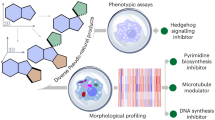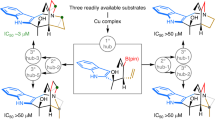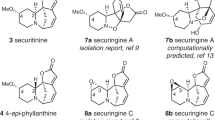Abstract
To access architecturally complex natural products, chemists usually devise a customized synthetic strategy for constructing a single target skeleton. In contrast, biosynthetic assembly lines often employ divergent intramolecular cyclizations of a polyunsaturated common intermediate to produce diverse arrays of scaffolds. With the aim of integrating such biogenetic strategies, we show the development of an artificial divergent assembly line generating unprecedented numbers of scaffold variations of terpenoid indole alkaloids. This approach not only allows practical access to multipotent intermediates, but also enables systematic diversification of skeletal, stereochemical and functional group properties without structural simplification of naturally occurring alkaloids. Three distinct modes of [4+2] cyclizations and two types of redox-mediated annulations provided divergent access to five skeletally distinct scaffolds involving iboga-, aspidosperma-, andranginine- and ngouniensine-type skeletons and a non-natural variant within six to nine steps from tryptamine. The efficiency of our approach was demonstrated by successful total syntheses of (±)-vincadifformine, (±)-andranginine and (−)-catharanthine.
This is a preview of subscription content, access via your institution
Access options
Subscribe to this journal
Receive 12 print issues and online access
$259.00 per year
only $21.58 per issue
Buy this article
- Purchase on Springer Link
- Instant access to full article PDF
Prices may be subject to local taxes which are calculated during checkout




Similar content being viewed by others
References
Ganesan, A. The impact of natural products upon modern drug discovery. Curr. Opin. Chem. Biol. 12, 306–317 (2008).
Nielsen, T. E. & Schreiber, S. L. Towards the optimal screening collection. A synthesis strategy. Angew. Chem. Int. Ed. 47, 48–56 (2008).
Lachance, H., Wetzel, S., Kumar, K. & Waldmann, H. Charting, navigating, and populating natural product chemical space for drug discovery. J. Med. Chem. 55, 5989–6001 (2012).
Young, I. S. & Baran, P. S. Protecting-group-free synthesis as an opportunity for invention. Nature Chem. 1, 193–205 (2009).
Jones, S. B., Simmons, B., Mastracchio, A. & MacMillan, D. W. C. Collective synthesis of natural products by means of organocascade catalysis. Nature 475, 183–188 (2011).
Snyder, S. A., Gollner, A. & Chiriac, M. I. Regioselective reactions for programmable resveratrol oligomer synthesis. Nature 474, 461–465 (2011).
Oguri, H. et al. Generation of anti-trypanosomal agents through concise synthesis and structural diversification of sesquiterpene analogs. J. Am. Chem. Soc. 133, 7096–7105 (2011).
Balthaser, B. R., Maloney, M. C., Beeler, A. B., Porco, J. A. & Snyder, J. K. Remodelling of the natural product fumagillol employing a reaction discovery approach. Nature Chem. 3, 969–973 (2011).
Aquino, C. et al. A biomimetic polyketide-inspired approach to small-molecule ligand discovery. Nature Chem. 4, 99–104 (2012).
Bauer, R. A., Wenderski, T. A. & Tan, D. S. Biomimetic diversity-oriented synthesis of benzannulated medium rings via ring expansion. Nature Chem. Biol. 9, 21–29 (2013).
Huigens III, R. W. et al. A ring-distortion strategy to construct stereochemically complex and structurally diverse compounds from natural products. Nature Chem. 5, 195–202 (2013).
O'Connor, S. E. & Maresh, J. J. Chemistry and biology of monoterpene indole alkaloid biosynthesis. Nat. Prod. Rep. 23, 532–547 (2006).
Stocking, E. M. & Williams, R. M. Chemistry and biology of biosynthetic Diels–Alder reactions. Angew. Chem. Int. Ed. 42, 3078–3115 (2003).
Danieli, B., Lesma, G., Martinelli, M., Passarella, D. & Silvani, A. Diastereoselective synthesis of 3-oxo-14,15-dihydroandranginine. J. Org. Chem. 62, 6519–6523 (1997).
Finefield, J. M., Sherman, D. H., Kreitman, M. & Williams, R. M. Enantiomeric natural products: occurrence and biogenesis. Angew. Chem. Int. Ed. 51, 4802–4836 (2012).
Oikawa, H. & Tokiwano, T. Enzymatic catalysis of the Diels–Alder reaction in the biosynthesis of natural products. Nat. Prod. Rep. 21, 321–352 (2004).
Kim, J. & Movassaghi, M. Biogenetically inspired syntheses of alkaloid natural products. Chem. Soc. Rev. 38, 3035–3050 (2009).
Massiot, G. et al. Structures of ngouniensine: an indole alkaloid of a new type from Strychnos ngouniensis. J. Chem. Soc. Chem. Commun. 768–769 (1982).
Abbiati, G. et al. Sequential amination/annulation/aromatization reaction of carbonyl compounds and propargylamine: a new one-pot approach to functionalized pyridines. J. Org. Chem. 68, 6959–6966 (2003).
Cacchi, S., Fabrizi, G. & Filisti, E. N-Propargylic β-enaminones: common intermediates for the synthesis of polysubstituted pyrroles and pyridines. Org. Lett. 10, 2629–2632 (2008).
Colby, D. A., Bergman, R. G. & Ellman, J. A. Synthesis of dihydropyridines and pyridines from imines and alkynes via C–H activation. J. Am. Chem. Soc. 130, 3645–3651 (2008).
Kim, H. & Lee, C. Rhodium-catalyzed cycloisomerization of N-propargyl enamine derivatives. J. Am. Chem. Soc. 128, 6336–6337 (2006).
Martins, M. A. P. et al. Intramolecular cyclization of N-propargylic β-enaminones catalyzed by silver. Tetrahedron Lett. 54, 847–849 (2013).
Kim, H-S., Kim, J-W., Kwon, S-C., Shim, S-C. & Kim, T-J. Catalytic formation of carbamates and cyclic carbonates by copper complex of 2,5,19,22-tetraaza[6,6](1,1′)ferrocenophane-1,5-diene X-ray crystal structure of [Cu(I)]PF6 . J. Organomet. Chem. 545–546, 337–344 (1997).
Chen, P., Cao, L. & Li, C. Protecting-group-free total synthesis of (±)-subincanadine F. J. Org. Chem. 74, 7533–7535 (2009).
Kuehne, M. E., Bornmann, W. G., Earley, W. G. & Marko, I. Studies in biomimetic alkaloid syntheses. 14. Controlled, selective syntheses of catharanthine and tabersonine, and related desethyl compounds, through generation of 15-oxosecodine intermediates. J. Org. Chem. 51, 2913–2927 (1986).
Passarella, D., Martinelli, M., Llor, N., Amat, M. & Bosch, J. Biomimetic construction of the tetracyclic ring system of ngouniensine. Tetrahedron 55, 14995–15000 (1999).
Wilson, R. M., Farr, R. A. & Burlett, D. J. Synthesis and chemistry of a stabilized dehydrosecodine model system. J. Org. Chem. 46, 3293–3302 (1981).
Yoon, T. P., Ischay, M. A. & Du, J. Visible light photocatalysis as a greener approach to photochemical synthesis. Nature Chem. 2, 527–532 (2010).
Tucker, J. W. & Stephenson, C. R. J. Shining light on photoredox catalysis: theory and synthetic applications. J. Org. Chem. 77, 1617–1622 (2012).
Prier, C. K., Rankic, D. A. & MacMillan, D. W. C. Visible light photoredox catalysis with transition metal complexes: applications in organic synthesis. Chem. Rev. 113, 5322–5363 (2013).
Kutney, J. P. et al. The total synthesis of some monomeric Vinca alkaloids: dl-vincadine, dl-vincaminoreine, dl-vincaminorine, dl-vincadifformine, dl-minovine, and dl-vincaminoridine. J. Am. Chem. Soc. 90, 3891–3893 (1968).
Kuehne, M. E., Wang, T. & Seaton, P. J. Total syntheses of vincadifformine, 3-oxovincadifformine, pseudo-and-20-epi-pseudo-vincadifformine, tabersonine, and Δ18-tabersonine through radical reactions and Heck reactions. J. Org. Chem. 61, 6001–6008 (1996).
Kobayashi, S., Peng, G. & Fukuyama, T. Efficient total syntheses of (±)-vincadifformine and (−)-tabersonine. Tetrahedron Lett. 40, 1519–1522 (1999).
Pandey, G. & Kumara, C. P. Iminium ion cascade reaction in the total synthesis of (+)-vincadifformine. Org. Lett. 13, 4672–4675 (2011).
Mi, Y., Schreiber, J. V. & Corey, E. J. Total synthesis of (+)-α-onocerin in four steps via four-component coupling and tetracyclization steps. J. Am. Chem. Soc. 124, 11290–11291 (2002).
Riche, C. & Pascard-Billy, C. Structure and stereochemistry of indole alkaloids. IV. Structure of andranginine. Acta Crystallogr. B B35, 666–669 (1979).
Kan-Fan, C. et al. Structure and biogenetic-type synthesis of andranginine: an indole alkaloid of a new type. J. Chem. Soc. Chem. Commun. 164–165 (1974).
Yanagisawa, A., Nomura, N. & Yamamoto, H. Transition metal-catalyzed substitution reaction of allylic phosphates with Grignard reagents. Tetrahedron 50, 6017–6028 (1994).
Büchi, G., Kulsa, P., Ogasawara, K. & Rosati, R. L. Syntheses of velbanamine and catharanthine. J. Am. Chem. Soc. 92, 999–1005 (1970).
Kutney, J. P. & Bylsma, F. Synthesis of monomeric and dimeric vinca alkaloids. The total synthesis of isovelbanamine, velbanamine, cleavamine, 18β-carbomethoxycleavamine, and catharanthine. J. Am. Chem. Soc. 92, 6090–6092 (1970).
Trost, B. M., Godleski, S. A. & Belletire, J. L. Synthesis of (±)-catharanthine via organopalladium chemistry. J. Org. Chem. 44, 2052–2054 (1979).
Atta-ur-Rahman, Beisler J. A. & Harley-Mason, J. The total syntheses of (±)-α- and β-dihydrocleavamines, (±)-16-methoxycarbonyldihydrocleavamine, (±)-coronaridine, (±)-dihydrocatharanthine, (±)-ibogamine, (±)-epi-ibogamine, and (±)-catharanthine. Tetrahedron 36, 1063–1070 (1980).
Marazano, C., Le, G. M. T., Fourrey, J. L. & Das, B. C. An unequivocal synthesis of 1-benzyl-3-ethyl-1,6-dihydropyridine and its use for a biogenetically modeled synthesis of (±)-catharanthine. J. Chem. Soc. Chem. Commun. 389–391 (1981).
Imanishi, T., Yagi, N., Shin, H. & Hanaoka, M. 1,6-Dihydro-3(2H)-pyridinones. III. A formal synthesis of (±)-catharanthine. Chem. Pharm. Bull. 30, 4052–4059 (1982).
Raucher, S. & Bray, B. L. Total synthesis of (±)-catharanthine. J. Org. Chem. 50, 3236–3237 (1985).
Raucher, S., Bray, B. L. & Lawrence, R. F. Synthesis of (±)-catharanthine, (+)-anhydrovinblastine, and (−)-anhydrovincovaline. J. Am. Chem. Soc. 109, 442–446 (1987).
Szántay, C., Bölcskei, H. & Gács-Baitz, E. Synthesis of vinca alkaloids and related compounds XLVIII synthesis of (+)-catharanthine and (±)-allocatharanthine. Tetrahedron 46, 1711–1732 (1990).
Reding, M. T., Kaburagi, Y., Tokuyama, H. & Fukuyama, T. Synthesis of 2,3-disubstituted indoles by radical cyclization with hypophosphorous acid and its application to total synthesis of (±)-catharanthine. Heterocycles 56, 313–330 (2002).
Moisan, L., Thuery, P., Nicolas, M., Doris, E. & Rousseau, B. Formal synthesis of (+)-catharanthine. Angew. Chem. Int. Ed. 45, 5334–5336 (2006).
Acknowledgements
The authors dedicate this manuscript to Masahiro Hirama on the occasion of his 65th birthday. The authors thank Y. Fujimura (Shionogi & Co.) and T. Matsumoto (Rigaku Corporation) for performing X-ray analyses. This work was supported by JSPS KAKENHI (grant no. 23310156 to H. Oguri) and in part by the Naito Foundation and the Science and Technology Research Partnership for Sustainable Development Program (SATREPS) of the Japan Science and Technology Agency (JST). The authors acknowledge a fellowship for H.M. from the JSPS.
Author information
Authors and Affiliations
Contributions
H.M. carried out the experimental work. H.M. and H. Oguri conceived the projects, analysed the experimental results and wrote the manuscript. H. Oikawa discussed the results and provided oversight.
Corresponding author
Ethics declarations
Competing interests
The authors declare no competing financial interests.
Supplementary information
Supplementary information
Supplementary information (PDF 4657 kb)
Supplementary information
Crystallographic data for compound 7 (CIF 35 kb)
Supplementary information
Crystallographic data for compound 48 (CIF 18 kb)
Rights and permissions
About this article
Cite this article
Mizoguchi, H., Oikawa, H. & Oguri, H. Biogenetically inspired synthesis and skeletal diversification of indole alkaloids. Nature Chem 6, 57–64 (2014). https://doi.org/10.1038/nchem.1798
Received:
Accepted:
Published:
Issue Date:
DOI: https://doi.org/10.1038/nchem.1798
This article is cited by
-
Modular assembly of indole alkaloids enabled by multicomponent reaction
Nature Communications (2023)
-
Controlled partial transfer hydrogenation of quinolines by cobalt-amido cooperative catalysis
Nature Communications (2020)
-
Innovation in protecting-group-free natural product synthesis
Nature Reviews Chemistry (2019)
-
Samarium(II) folding cascades involving hydrogen atom transfer for the synthesis of complex polycycles
Nature Communications (2018)
-
Diversity-oriented synthetic strategy for developing a chemical modulator of protein–protein interaction
Nature Communications (2016)




